Vehicle Emission Control Decal
Re: Vehicle Emission Control Decal
|
Thanks Jim, I too am happy to have find it.
Bought it at Greensales, they had more than 40 in stock! They shipped immediately, really happy about their service. There were 3 other stores on Rearcounter claiming they had 1 to 3 in stock, so in fact there’s not a lot available. About installation, I found this on web: « That vacuum restrictor can be installed any direction. It isn't a check valve, it's just a pinhole opening for slowly bleeding air.» Anyone has a comment about this?
Jeff / 1984 F350 Crew Cab 4x4/5.8L w351 4V/ T18/ D50 4.10 front/ 8' bed.
Restored 2019-2022. Nicknamed «Big Brother 1984», due to its soooo-looong shape & nod to George Orwell's 1984 famous novel. |
Re: Vehicle Emission Control Decal
|
Administrator
|
Suck it and see...
No, I don't believe they have any direction. (at least mine doesn't)
Jim,
Lil'Red is a '87 F250 HD, 4.10's, 1356 4x4, Zf-5, 3G, PMGR, Saginaw PS, desmogged with a Holley 80508 and Performer intake. Too much other stuff to mention. |
Re: Vehicle Emission Control Decal
LOL! I already did it before posting  and well, the air seems to flow equally in either direction. and well, the air seems to flow equally in either direction.
Looks that it can be installed in any ways.
Jeff / 1984 F350 Crew Cab 4x4/5.8L w351 4V/ T18/ D50 4.10 front/ 8' bed.
Restored 2019-2022. Nicknamed «Big Brother 1984», due to its soooo-looong shape & nod to George Orwell's 1984 famous novel. |
Re: Vehicle Emission Control Decal
|
Administrator
|
In reply to this post by ArdWrknTrk
(Jim - He's gonna be pleasantly surprised. But let him find out on his own.
 ) )
Gary, AKA "Gary fellow": Profile
Dad's: '81 F150 Ranger XLT 4x4: Down for restomod: Full-roller "stroked 351M" w/Trick Flow heads & intake, EEC-V SEFI/E4OD/3.50 gears w/Kevlar clutches
|
Re: Vehicle Emission Control Decal
|
Gentlemen, trying to clarify the Ported Vacuum Switch (3 port) behavior.
Between the two scenarios below, which one is right?  Scenario 1 (3 stages): 1- Engine cold: Completely closed, no vacuum so no ignition advance. 2- Engine warm: Port 1 (with the restrictor) connects to port D (distributor), a little timing advance is allowed. 3- Engine getting hot: The switch flips from Port 1 to Port 2 (unrestricted) and provides full manifold vacuum to port D (distributor), so you get more advance, the water pump and fan run faster, allowing the engine to cool down. Scenario 2 (2 stages): 1- Engine cold and warm: Port 1 (with the restrictor) connected to port D (distributor), allowing little timing advance. 2- Engine getting hot: The switch flips from Port 1 to Port 2 (unrestricted) and provides full manifold vacuum to port D (distributor), so you get more advance, the water pump and fan run faster, allowing the engine to cool down.
Jeff / 1984 F350 Crew Cab 4x4/5.8L w351 4V/ T18/ D50 4.10 front/ 8' bed.
Restored 2019-2022. Nicknamed «Big Brother 1984», due to its soooo-looong shape & nod to George Orwell's 1984 famous novel. |
Re: Vehicle Emission Control Decal
|
Administrator
|
Scenario 2 is almost correct.
The system is there to keep the engine within operating parameters... Cold and at temperature restricted vacuum reaches the distributor. Only when the coolant temperature far exceeds normal operating temperature should the thermal vacuum valve switch ports and apply unrestricted manifold vacuum. Ports in my yellow valve shift well above the boiling point of water at STP. (perhaps 220~225°F) Maybe Ralph or Gary knows what temp yours shifts at
Jim,
Lil'Red is a '87 F250 HD, 4.10's, 1356 4x4, Zf-5, 3G, PMGR, Saginaw PS, desmogged with a Holley 80508 and Performer intake. Too much other stuff to mention. |
Re: Vehicle Emission Control Decal
 So, there’s alway a bit of vacuum applied to the distributor diaphragm. I suppose that at idle, the succion is really low, so almost no timing advance.
Jeff / 1984 F350 Crew Cab 4x4/5.8L w351 4V/ T18/ D50 4.10 front/ 8' bed.
Restored 2019-2022. Nicknamed «Big Brother 1984», due to its soooo-looong shape & nod to George Orwell's 1984 famous novel. |
Re: Vehicle Emission Control Decal
|
Administrator
|
Jim - I don't know what temp causes the valve to open and don't see anything in the catalog that says.
Jeff - As long as your vacuum cannister doesn't have a leak you will eventually get full vacuum even with the restrictor in. All it does is slow transitions down, not reduce them. If you have a vacuum gauge you can prove that to yourself by pulling the line off the distributor and placing it on the gauge. When the engine starts you'll see the vacuum come up slowly to full manifold vacuum - assuming that your system uses manifold instead of ported vacuum. (Looking at your diagram I see that it goes to the carb, but don't remember if that is ported or manifold. Surely manifold or the engine couldn't speed up at idle if it got hot.) To explain how this works lets discuss a parallel system - electricity. The equation E=IR gives the voltage drop across a resistor which is directly dependent on the current through the resistor. Zero current gives zero voltage drop. But your restrictor is equivalent to a resistor. When the engine starts there is a little bit of air in the vacuum cannister in the distributor, so there's a bit of flow (current) through the restrictor as the air is sucked out, so there's a "vacuum drop" across the restrictor. But when the air is fully out there's no flow and, therefore, no vacuum drop across the restrictor.
Gary, AKA "Gary fellow": Profile
Dad's: '81 F150 Ranger XLT 4x4: Down for restomod: Full-roller "stroked 351M" w/Trick Flow heads & intake, EEC-V SEFI/E4OD/3.50 gears w/Kevlar clutches
|
Re: Vehicle Emission Control Decal
|
I know they are color coded by temp.
Here is a list. 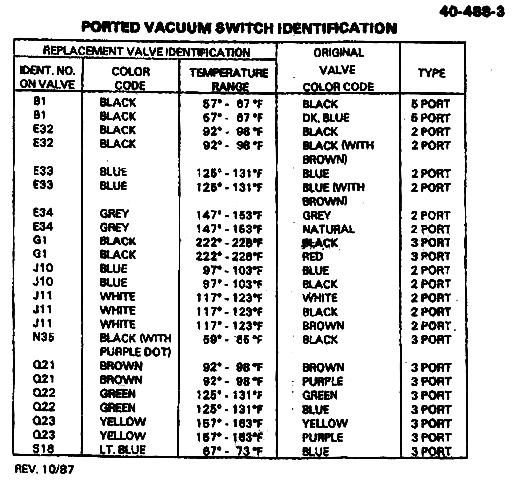
Truck: 1981 F-150 Explorer / Engine: 300-6 California MCU Feedback System / Trans: T-18 - 4 speed / 2.75 Ford Rear Axle Open Diff.
|
Re: Vehicle Emission Control Decal
|
Administrator
|
Great info Ralph!
 And it seems I have been giving bad information about how mine (yellow) functions. My apologies to Jeff who had it right with his second scenario, and anyone who took my word for gospel. 
Jim,
Lil'Red is a '87 F250 HD, 4.10's, 1356 4x4, Zf-5, 3G, PMGR, Saginaw PS, desmogged with a Holley 80508 and Performer intake. Too much other stuff to mention. |
Re: Vehicle Emission Control Decal
|
In reply to this post by Gary Lewis
Gary, noobie is lost. Sorry.  You-Explain-Me.  Hope this picture will help to determine what kind of vacuum source it is (ported or manifold). Assuming the location of the connection on the carb side, I suppose this is a “ported” source? 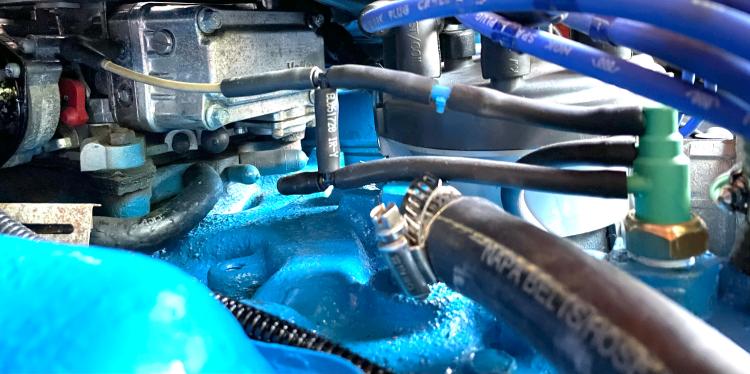
Jeff / 1984 F350 Crew Cab 4x4/5.8L w351 4V/ T18/ D50 4.10 front/ 8' bed.
Restored 2019-2022. Nicknamed «Big Brother 1984», due to its soooo-looong shape & nod to George Orwell's 1984 famous novel. |
Re: Vehicle Emission Control Decal
|
Administrator
|
Jeff, yes that port high on the choke side is timed or ported vacuum.
In your diagram you can see the line going to the thermal switch is shown in red. By convention Ford vacuum lines are: Red = manifold White = ported Black = switched or delayed Green = switched for EGR/A.I.R.  For manifold vacuum id suggest going to the capped port in the base flange, directly behind the lower tee.
Jim,
Lil'Red is a '87 F250 HD, 4.10's, 1356 4x4, Zf-5, 3G, PMGR, Saginaw PS, desmogged with a Holley 80508 and Performer intake. Too much other stuff to mention. |
Re: Vehicle Emission Control Decal
|
Administrator
|
Thanks, Jim. I forgot about the color coding.

Gary, AKA "Gary fellow": Profile
Dad's: '81 F150 Ranger XLT 4x4: Down for restomod: Full-roller "stroked 351M" w/Trick Flow heads & intake, EEC-V SEFI/E4OD/3.50 gears w/Kevlar clutches
|
Re: Vehicle Emission Control Decal
|
In reply to this post by ArdWrknTrk
Thanks Jim, one more piece of knowledge for the dummy!
 Are you referring to this capped port? 
Jeff / 1984 F350 Crew Cab 4x4/5.8L w351 4V/ T18/ D50 4.10 front/ 8' bed.
Restored 2019-2022. Nicknamed «Big Brother 1984», due to its soooo-looong shape & nod to George Orwell's 1984 famous novel. |
Re: Vehicle Emission Control Decal
|
Administrator
|
Either of the two in the carburetor flange above, or that port in the spacer should all be manifold vacuum. (I'd think)
I know Big Brother isn't exactly as he rolled off the assembly line, and that trucks for the Canadian market differ a little from ours here in the US.
Jim,
Lil'Red is a '87 F250 HD, 4.10's, 1356 4x4, Zf-5, 3G, PMGR, Saginaw PS, desmogged with a Holley 80508 and Performer intake. Too much other stuff to mention. |
Re: Vehicle Emission Control Decal

Jeff / 1984 F350 Crew Cab 4x4/5.8L w351 4V/ T18/ D50 4.10 front/ 8' bed.
Restored 2019-2022. Nicknamed «Big Brother 1984», due to its soooo-looong shape & nod to George Orwell's 1984 famous novel. |
Re: Vehicle Emission Control Decal
|
In reply to this post by ArdWrknTrk
Guys, sometimes I have a flash during the night. It just happens like that, boom.
This morning I woke up this way. «Eureka! I found it!». Some of my Newbie brain’s neurons (I have one?) connected, and made me realize that this nice symbol, that I reproduced so carefully (without understanding what I was doing), is in fact a nice small 3 port PVS illustrated lying on its side: 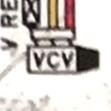 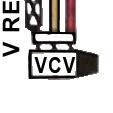 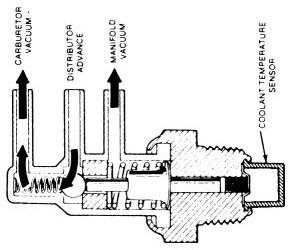 That said: A- Port 1 (restricted) and 3 (direct), which are connected together on the diagram, are now plugged to the manifold. B- Starting the engine and moving Big Bro, I heard he is pinking a little bit. C- I am a brave little Nooobie, so I bought a strobe light and am willing to learn the timing adjustments skills. If you have time to help me…  So, assuming Big Bro’s timing (with no vacuum advance) was correct, how should I proceed?
Jeff / 1984 F350 Crew Cab 4x4/5.8L w351 4V/ T18/ D50 4.10 front/ 8' bed.
Restored 2019-2022. Nicknamed «Big Brother 1984», due to its soooo-looong shape & nod to George Orwell's 1984 famous novel. |
Re: Vehicle Emission Control Decal
|
Administrator
|
Do you have an adjustable vacuum advance, Jeff?
What is your base timing? And with the vacuum connected? Ideally you would back out a little advance by increasing spring pressure on the diaphragm. Instructions under documentation/electrical/ignition: https://www.garysgaragemahal.com/ignition.html
Jim,
Lil'Red is a '87 F250 HD, 4.10's, 1356 4x4, Zf-5, 3G, PMGR, Saginaw PS, desmogged with a Holley 80508 and Performer intake. Too much other stuff to mention. |
Re: Vehicle Emission Control Decal
|
Administrator
|
In reply to this post by BigBrother-84
I like that - "time" to help me.
 (Reminds me of Jim on Vicar of Dibley - "Show you the ropes".) (Reminds me of Jim on Vicar of Dibley - "Show you the ropes".)
I've been thinking about this and what I said earlier about there being full vacuum at the distributor even through the restriction, and I think I must have been wrong. That cannot be the case and have the engine speed up when the coolant temp gets "hot".  As for timing the engine, you pull the vacuum hose off the distributor and plug it. Clean both the timing pointer and the marks on the harmonic balancer, and put a but of chalk or white paint on the 10 degrees Before Top Dead Center on the balancer. Put the timing light's pickup on #1 plug wire and attach its power leads to the battery. Start the engine and if it is cold let it warm up so the choke and fast idle are off. Keeping your fingers away from the fan, point the timing light at the balancer/pointer combo and you should see the white @ 10 BTDC. If it isn't right at the edge of the pointer then loosen the hold-down bolt for the distributor. (It should be loose enough to let you turn the dizzy by hand, but tight enough that the dizzy doesn't move on its own.) Then turn the dizzy to bring the white mark to the edge of the pointer and snug the bolt down. Now put the vacuum line on the vacuum advance and the timing should advance into the 20's and the RPM will go up. Back off the idle stop screw to get the idle back where you want it and you are done. But, I'd do a test to see if everything is set up right. No, I don't think you want to get the coolant temp "hot", but you can simulate that. Note the RPM in "normal" mode and then switch to the manifold vacuum line, but plug the restricted line. The engine should speed up, indicating that when the temp does get "hot" it'll do the same and cool the engine. Last, I picked 10 degrees BTDC as a starting point. The specs may say 8, but 10 should be fine. You can go on up to 12 or so and get a bit more power and MPG, but you may also get some pinging under part throttle load. So give 10 a try and see if you want more.
Gary, AKA "Gary fellow": Profile
Dad's: '81 F150 Ranger XLT 4x4: Down for restomod: Full-roller "stroked 351M" w/Trick Flow heads & intake, EEC-V SEFI/E4OD/3.50 gears w/Kevlar clutches
|
Re: Vehicle Emission Control Decal
|
Administrator
|
Gary, the way I understood it on Darth, the restriction meant the vacuum advance came back in a little slower after accelerating (probably to help keep the NOX levels down) but with the engine hot it needed to come back in faster.
Bill AKA "LOBO" Profile
"Getting old is inevitable, growing up is optional" Darth Vader 1986 F350 460 converted to MAF/SEFI, E4OD 12X3 1/2 rear brakes, traction loc 3:55 gear, 160 amp 3G alternator Wife's 2011 Flex Limited Daily Driver 2009 Flex Limited with factory tow package Project car 1986 Chrysler LeBaron convertible 2.2L Turbo II, modified A413 |
| Edit this page |

